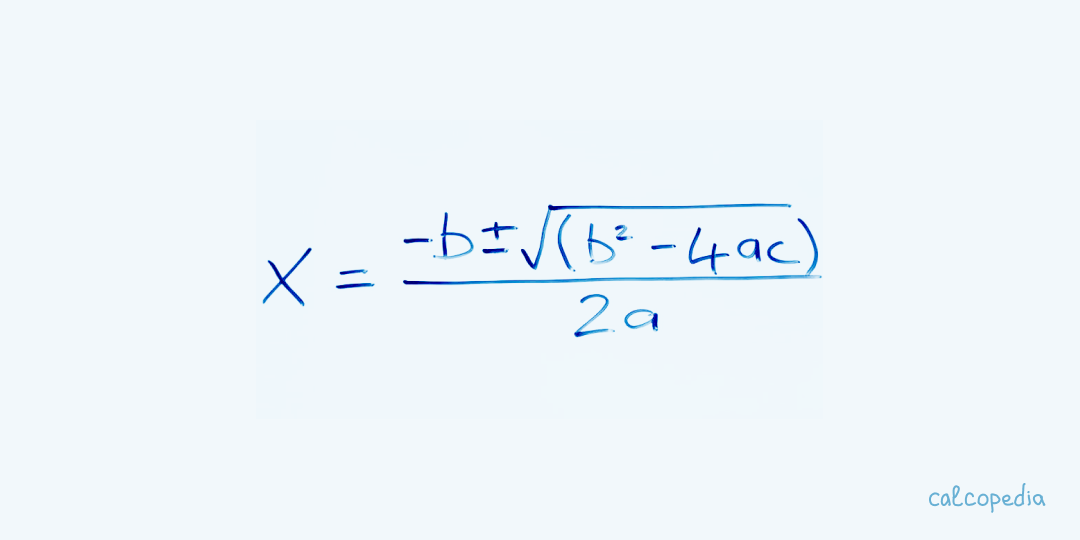Contents
What are Quadratic Equations and How Do We Solve Them?

A quadratic equation is a polynomial equation of the second degree. The general form is ax² + bx + c = 0, where a, b, and c are constants, and x represents an unknown variable.
The solutions for x, often known as the roots, can be found using the quadratic formula: x = (-b ± sqrt(b²-4ac)) / 2a
It`s fascinating to note that the term "quadratic" originates from the Latin word "quadratus," meaning square. This is because the degree of the primary term is squared.
The discriminant, represented by the formula b² - 4ac, plays a crucial role in determining the nature of the roots of a quadratic equation. It can be positive, negative, or zero, leading to different types of solutions.
How to Use the Quadratic Equation Calculator?
With the rise of technology, solving quadratic equations has become a breeze with online calculators. Let`s explore how to use one:
1. Begin by entering the coefficients a, b, and c from your quadratic equation.
2. Ensure that you've entered the correct signs (positive or negative) for each coefficient.
3. Click on the "Calculate" button to start the process.
4. The calculator will display the solutions for x based on the quadratic formula.
5. If the discriminant is positive, you'll receive two distinct real roots. If it`s zero, you'll get one real root. A negative discriminant indicates complex roots.
6. For better understanding, some calculators even provide a graphical representation of the equation.
7. Make sure to double-check your input values if the solutions seem off or unexpected.
Examples of Calculating Quadratic Equations
Quadratic equations appear in various real-life situations. Let`s explore a few humorous examples:
1. Alien Invasion: If an alien spaceship travels in a path represented by x² - 5x + 6 = 0, find the points where we can intercept them! Solving, we get x = 2 and x = 3. So, set up the defense at these points!
2. Pizza Party: You throw a pizza in the air, and its height as a function of time is given by -16t² + 32t + 5 = 0. Find when the pizza will hit the ground, so you can catch it. The positive root will be the time it takes!
3. Love Life: Your love life`s trajectory is given by x² - 4x + 4 = 0. Find when you'll meet your true love. Spoiler: The roots are real and identical, meaning you've already met them!
Nuances of Calculating Quadratic Equations
While quadratic equations can be fun, there are certain nuances to keep in mind:
1. Always check the discriminant to determine the nature of the roots.
2. If a = 0, then the equation is not quadratic. It`s linear!
3. Quadratic equations always have two roots, but they can be real or complex.
4. The vertex of the parabola represented by the equation is given by (-b/2a, c - b²/4a).
5. The axis of symmetry is given by x = -b/2a.
6. Complex roots always occur in conjugate pairs.
7. Quadratic equations can represent real-life situations, but ensure the context makes sense with the solutions.
8. Some quadratic equations can be factored easily, offering a quicker solution method.
9. The graph of a positive leading coefficient opens upwards, while a negative one opens downwards.
10. The maximum or minimum value of the quadratic function occurs at the vertex.
Frequently Asked Questions About Calculating Quadratic Equations
Why are there sometimes two solutions?
Quadratic equations can have up to two distinct roots because of the squared term. Depending on the discriminant, these can be real or complex.
What if my leading coefficient is zero?
If a = 0, the equation is not quadratic but linear. You won`t need a quadratic formula for that!
Why do I get complex roots?
Complex roots arise when the discriminant is negative. This means the parabola represented by the equation doesn`t intersect the x-axis.
Can I always use the quadratic formula?
Yes, the quadratic formula always works for any quadratic equation, but sometimes factoring or completing the square might be easier methods.
Is the graph always a parabola?
Yes, the graph of a quadratic equation is always a parabola. Its direction (upwards or downwards) depends on the sign of the leading coefficient.
Similar calculators
You may find the following calculators on the same topic useful:
- Millimeters to Inches Length Conversion Calculator. Precisely convert millimeters to inches for diverse applications in engineering, crafting, and general measurements.
- Inches to Millimeters Length Conversion Calculator. Efficiently convert inches to millimeters for precision in engineering, crafting, and other measurement-sensitive tasks.
- Centimeters to Inches Length Conversion Calculator. Quickly and precisely convert centimeters to inches for use in various fields like construction, crafting, and daily life.
- Inches to Centimeters Length Conversion Calculator. Accurately convert inches to centimeters for various applications in construction, crafting, and everyday measurements.
- Liters to Gallons Volume Conversion Calculator. Accurately convert liquid volumes from liters to gallons for culinary, scientific, or everyday purposes.
- Gallons to Liters Volume Conversion Calculator. Effortlessly convert liquid volumes from gallons to liters for culinary, scientific, or general use.
- m/s to Km/h Speed Conversion Calculator. Quickly convert speeds from meters per second to kilometers per hour for scientific, educational, or practical uses.
- Km/h to m/s Speed Conversion Calculator. Easily convert speeds from kilometers per hour to meters per second for academic, scientific, or practical use.
- Number System Conversion Calculator. Efficiently convert numbers between binary, decimal, octal, and hexadecimal systems for diverse mathematical and computing applications.
- Hexadecimal to Decimal Calculator. Rapid and precise conversion of hexadecimal numbers to decimal format, suitable for advanced programming and IT tasks.
Share on social media
If you liked it, please share the calculator on your social media platforms. It`s easy for you and beneficial for the project`s promotion. Thank you!